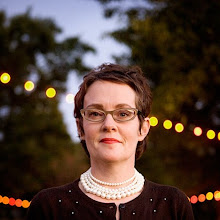
Inside the Renwick Gallery. all photos courtesy the author.
I'm just wrapping up a day in D.C. doing the people's business. I've gone through jury duty twice recently--both in Phoenix, oddly enough--but I never get on the jury. Perhaps being of a certain age gives you both knowledge and baggage that could be compromising in that kind of context?
But when I review proposals for the National Endowment for the Arts, the Institute of Museum and Library Services, a state or city arts organization, I feel I am contributing my expertise to the benefit of public culture. Given the intelligent level of discussion that goes on in D.C. with regards to our field, I feel proud of my professional colleagues and the hard-working staff at our nation's agencies.

Romaine Brooks, Self-Portrait, 1923
The secondary benefit, of course, to being in D.C. is to experience more art. Yesterday's menu: The Renwick Gallery, the International Spy Museum and the National Building Museum.
The Renwick had a great show The Art of Gaman: Arts and Crafts from the Japanese American Internment Camps, 1942-1946. Sadly the catalogue was sold out, but there were some lovely gems in the show, including a work by Noguchi (not made while he was in camp). Noguchi was outside the affected zone for internment, but the US government suggested he go into the camps willingly to demonstrate that the camps weren't bad. Noguchi was assured he could leave when he wanted to, but when he asked to be released, they kept him inside.
Next was the International Spy Museum. I learned that the Renaissance architect Leon Battista Alberti invented the cipher disc which has been used for centuries to encode messages. See how an artist's unique training can generate something used for good (and bad of course)?
Finally a stop at the National Building Museum for a show about the architecture of parking ramps, a necessary modern evil. Given that America is grappling with the problem of automobiles, after conquering this unruly country through its use, we should see parking ramps as a soon-to-be-relic. A thousand years from now, archaeologists will wonder what we worshiped in these temples.
In any case, what I take away from these few days in D.C. is that, from its beginning, this country saw the arts as an important part of its self-definition--look at the variety of organizations one can visit in an afternoon. It is also noteworthy that museums are willing to take on an episode as shameful as the jailing of American citizens due to prejudice and fear. That is the democratic voice expressed through objects.
It is clear, however, that we are at a crossroads in describing the arts' value in and to civil society. We in the non-profit arts need to reaffirm the value we have in light of permanently diminished funding by re-imagining, as artists do, what the democratic ideal can be.




No comments:
Post a Comment